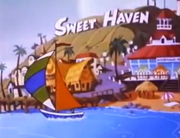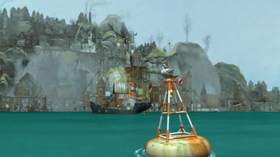This article is about the fictional location. For the song, see Sweethaven - An Anthem.

Sweethaven
Sweethaven is the name of the town where Popeye and his friends live, according to Robert Altman's 1980 film Popeye. It is depicted as a small seaside village, made of wooden houses with a large port, as opposed to the larger settlement they inhabit in many comics and cartoons, though still retaining the rustic look of the port featured in the original Thimble Theatre.
Setting[]

Popeye's hometown on a sea-surrounded area, on a map illustrated by Bud Sagendorf
Popeye's hometown originally went unnamed in past incarnations prior to the film, but the most common trait between them was that it was in or near the port as was needed due to Popeye's occupation as a sailor. The town as originally depicted was a humble little locale including a rustic port town, a small district with buildings and a countryside by the sea with a number of houses where most of the main characters resided. The location of the town as presented by Bud Sagendorf was on a peninsula or an island which allowed access to several strange and unique islands, such as Dice Island, Goon Island, Spinachovia, Demonia and many more. As depicted in the 1980 film, the town is shown to have its own anthem, suggesting that Sweethaven may actually be its own island nation; however, if this were to be true for the original depiction of Popeye's hometown (as would match its apparent disconnection from the rest of the world) it may mean that the island itself is a self-governing insular territory of the United States, fitting the portrayal of the characters as US citizens in the comics and cartoons, their occasionally mentioning the place was part of America while using US currency, and the presence of what seems to be a US flag on the Tax Collector's bike in the live-action film. It is also required to be a US citizen to permanently reside in Sweethaven, as seen in a comic strip storyline involving Toar, who needed to take both a citizenship test and prove to be of value to the country's workforce.
The world of Popeye[]
The world of Popeye as depicted in the original comics was portrayed as being disconnected from real world events due to its insular setting that seemed to belong to a world all its own, with many unique seas and islands that could be reached from Popeye's hometown.
However, real world countries still existed and would be used as references or visited but it would seem as though major events that happened in the real world, such as crises and wars, did not occur in this setting, or at least in Popeye's hometown these situations did not affect them, other than possibly the Great Depression, the League of Nations and the Prohibition (which was mentioned numerous times).
Segar's strips were almost certainly set somewhere around California, as Popeye is a charter member of the Santa Monica Rod and Reel club, and Santa Monica is about an hour's train ride from Popeye's hometown. Popeye can also walk to the American Southwest. Popeye's town is coastal, and has a large metropolitan area, which can be viewed in the story "Star Reporter".
This was different in the cartoons by Fleischer Studios, where signs of the Great Depression were present and clearly visible in many shorts, and later cartoons by both Fleischer and Famous Studios even had Popeye get involved in World War II by joining the U. S. Navy. However, the comics themselves and later cartoons would avoid mentioning any real-world events and would limit themselves to referencing real-world locations, which, as in the original Thimble Theatre, kept Popeye's homeland in a world all its own.
Anthem[]
The town of Sweethaven as depicted in the 1980 film, has its own anthem, which its people sing with great pride. The song was composed by Harry Nilsson.
Notable locations[]
The following is a list of locations in Sweethaven that have been seen or mentioned throughout Popeye media.
Residences and Lodgings[]
- Popeye's Home
- Oyl Residence
- Poopdeck's Boat
- Seafarer's Hotel
Businesses[]
- Rough House Cafe
- Popeye's Palace Cafe (out of business)
- Geezil's Businesses
- Wimpy's
- Castor Oyl Detective Agency
- Prof. Brainstine (pharmacy)
- Warbucks Bank & Trust
- Boat Shop
- Bait Shop
- Hardware Store
- Wimpy Co.
Entertainment[]
- Thimble Palace
- Thimble Theatre
- Max and Son's Square Gardens
- Downtown Arena
- Sweethaven Race Track
- The Wharf Club
- Kit Cat Club
- Pier 29
Others[]
- Popeye's Private Pier
- Church
- Light House
- Sweethaven School
- Offices of Dear Old Uncle Sam
- Sweethaven Fire Department
- Sailor's Union Office
Setting history[]
Thimble Theatre[]

Alice the Goon leaving Popeye's port town in Thimble Theatre
In the original comic strip by E. C. Segar known as Thimble Theatre, Popeye's hometown originally went unnamed and was portrayed as a humble port town with a large port, a few modern conveniences and rustic houses for the time of the comic's run between 1919 and 1938.
In Bud Sagendorf's continuation of the comic, it was regularly portrayed as a humble little town with rustic houses and buildings that occasionally had modern conveniences or buildings to suit a particular story. Popeye and his friends were shown as regularly living in small little rustic houses close to the sea and the town itself according to maps as drawn by Sagendorf was actually an island in an unknown archipelago that was presumably close to America and Spinachovia, and closer still to Ghost Island.
Fleischer Studios[]
In the 1933 to 1942 Fleischer Studios cartoons, Popeye's unnamed hometown was prone to frequent redesigns to suit the story of a short, but most commonly among all the shorts was that Popeye was portrayed as living in the rundown part of town near the port in either his ship or an apartment, and rarely later on as living in a modest home in a neighborhood in the countryside. This was used to reflect the difficult times of the Great Depression as well as Popeye's difficulty as a lower class man. The town he lived in was usually portrayed as being a small neighborhood close to the sea or somewhere in the country, but most commonly it was a small city near the port that usually looked run-down.
Famous Studios[]
Due to the even more episodic nature of the 1942-to-1957 Famous Studios cartoons, Popeye's place of residence saw more constant changes than usual, and the majority of shorts took place while Popeye was on vacation or in certain parts of the US, so no definitive or recurring towns existed within these cartoons. However, one short in particular (She-Sick Sailors) shows a train station that would seem to identify Popeye's hometown with the real-life city of Bridgeport, Connecticut.
Popeye's first TV series[]
In the 1960s Popeye television cartoon, Popeye's hometown also goes unnamed, but is consistently shown to resemble its appearance in the original Thimble Theatre as a small simple town near the port with a few a modern attractions, and the characters were regularly portrayed as living in their same houses.
Popeye's first movie[]
Sweethaven first appeared in the 1980 film Popeye as depicted by Robert Altman. The town is quite rustic in comparison to the modest urban hometown of Popeye and his friends featured in the original Thimble Theatre. Sweethaven was portrayed by the Popeye Village in Malta, which was built for the occasion but still stands as a tourist attraction. Since its debut, 'Sweethaven' and/or this depiction of the town have been used somewhat regularly in Popeye media.
Popeye and Son[]

Sweethaven in Popeye and Son
In the 1987 TV series Popeye and Son, the town is also identified as Sweethaven, notably in the opening animation by the huge sign spelling "SWEET HAVEN" on a hill, not unlike the Hollywood Sign. Again shown as a small seaside town, as in the earlier film, in this setting later in Popeye's life it is seen to have grown and modernized considerably. It now resembles the somewhat more urbanized locale from the old comics and cartoons, yet slightly more so due to the presence of many new attractions meant to appeal to a newer generation of kids.
Popeye's Voyage: The Quest for Pappy[]

Sweethaven in Popeye's Voyage: The Quest for Pappy
In the 2004 CGI film, Popeye's Voyage: The Quest for Pappy, Sweethaven is shown once again resembling its film incarnation but is now far bigger with even more houses, ports and piers, but is still just as rustic as ever.
